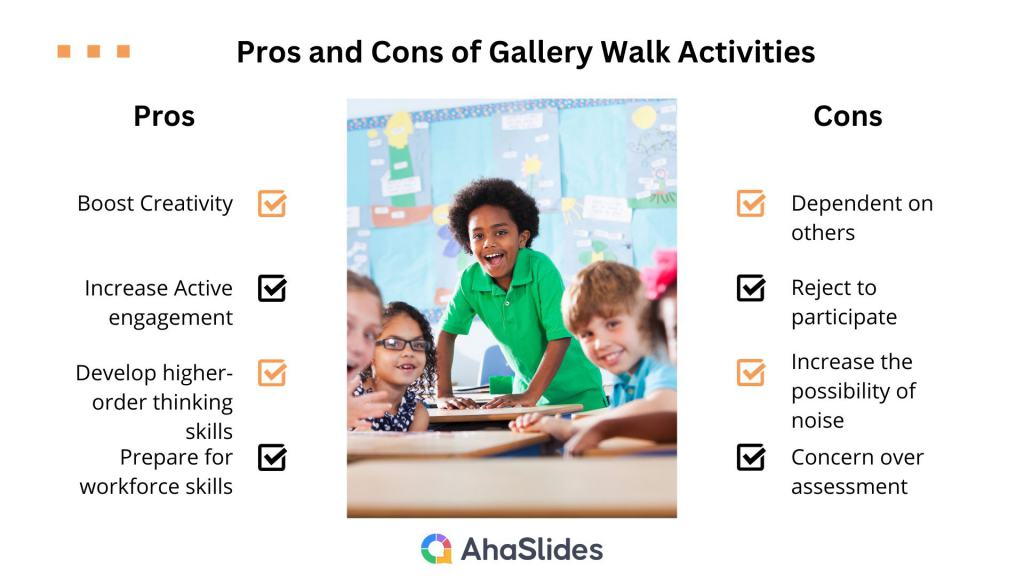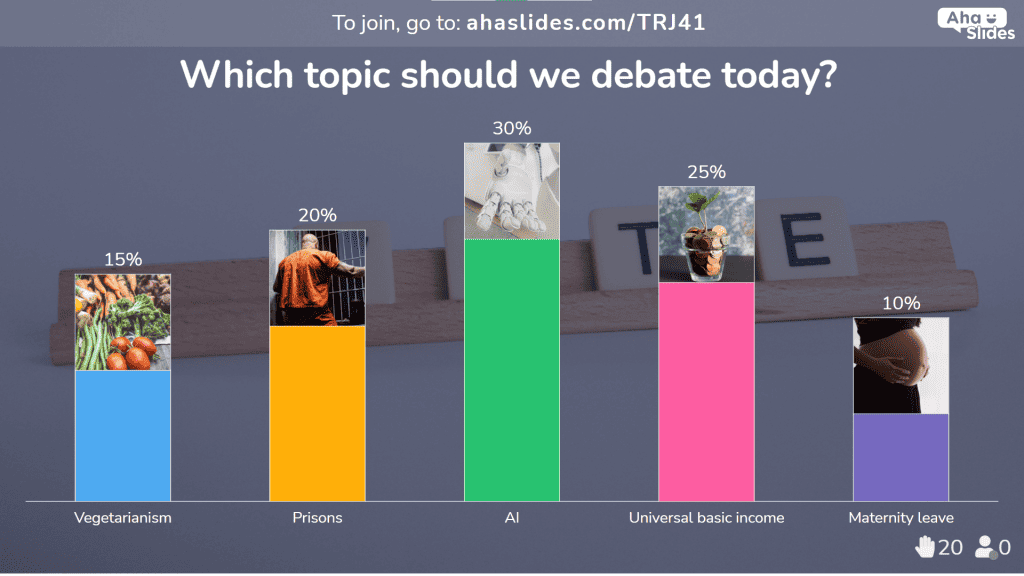畫廊漫步活動 當談到在課堂環境中創造引人入勝的討論時,這是最有效的教育策略之一。
對學生來說,這是一個在更親密、更支持性的環境中討論想法的機會,而不是在人數較多、匿名的課堂上。它為教育工作者提供了一個機會,可以評估學生對特定概念的學習深度,並糾正學生的誤解。本文將全面闡述「畫廊漫步活動」的概念。
目錄
畫廊漫步活動的概念
在畫廊漫步活動中,學生被分成小組,穿梭於不同的站點,完成每個站點的任務。從回答指定的問題開始,學生們互相分享答案,進行討論、給予回饋、辯論誰的答案更好,並投票選出最佳答案。
如今,不受實體地點限制的虛擬畫廊之旅越來越多。 在遠距學習中,來自世界各地的學生可以參加虛擬課堂,教師可以進行虛擬畫廊漫步活動。
提高參與度的技巧
畫廊漫步活動的優點
在教學中應用畫廊漫步活動可以帶來許多好處。 以下是該技術的主要優點:
#1. 提升創造力
畫廊漫步包含討論概念和學習他人想法的過程,這可以拓展他們的視野。此外,給予他人回饋也體現了批判性和分析性思維,使他們能夠更好地接受其他想法,避免輕易陷入群體思維。孩子可能會將自己和同伴視為知識淵博的個體,能夠透過畫廊漫步來引導和塑造自己和同伴的學習。因此,他們會產生更多創新和富有創意的想法。
#2. 增加 積極參與
根據 Hogan、Patrick 和 Cernisca 所做的一項研究 (2011), 學生認為畫廊漫步比講座式課程更能促進學生的參與。 畫廊漫步也加強了學生之間的活力和協作,從而提高了學生的參與度和更深層的參與(Ridwan,2015)。
#3。 培養高階思維能力
事實上,參加畫廊漫步活動需要教師在設計問題時選擇適當的抽象層次,並使用分析、評估和綜合等高階思維技能。 因此,與採用傳統方法教學的學生相比,採用畫廊漫步教學的學生經歷了更深入的學習。
#4。 為勞動力技能做好準備
Gallery Walk 體驗與工作場所相關。 學生可以培養就業技能,並為未來的工作做好準備,例如團隊合作和溝通,因為這些都是他們在學校期間在畫廊行走活動中所經歷的。 這些都是當今競爭激烈的勞動市場中所必需的技能。

畫廊漫步活動的缺點
儘管 Gallery Walk 帶來了很多好處,但也有其限制。 但不用擔心,我們提供了一些解決方案來幫助您防止這種情況發生。
#1. 依賴他人
小組中的一些學生可能不會積極參與知識建構。 在某種程度上,可以透過給每個小組的學生分配一定的職責,然後要求他們在到達下一站時輪換角色來解決這個問題。 在活動過程中,老師也可能會問學生一些評價性問題,讓他們回到任務上。
#2. 拒絕參加
另一方面,有些學生喜歡單獨學習,因此可能不想參與討論。 對於這些學習者,老師可以提及團隊合作的好處以及團隊合作對他們未來的幫助。
#3。 增加噪音的可能性
雖然畫廊漫步活動可以提高學生的活力和注意力,但糟糕的課堂管理可能會導致噪音水平高,降低學生的注意力,尤其是當學生們集體交談時。
#3。 對評估的關注
評價可能不公平。 教師可以透過事先制定評量標準並使學生熟悉來解決這個問題。 當然,學生腦中肯定有一些問題,例如,如何才能公平評分? 在一個團體中也不少嗎?
畫廊漫步活動的最佳創意
以下是一些畫廊漫步範例,教師可以將其納入課堂活動中:
- 腦力激盪會議:提出一個情境問題並要求學生進行腦力激盪。 如果是詞彙遊戲,則使用詞雲來激發他們的創造力。
- 現場問答:在畫廊漫步期間,您可以進行現場問答環節,學生可以就展示的內容提出問題。
- 即時民意調查:匿名民意調查可以幫助學生輕鬆分享他們的意見。
- 即時回饋:即時調查可以採用書面評論或簡短反思的形式。如果涉及對他人答案的回饋,則應以匿名形式進行。
- 清道夫:像要求學生解決難題一樣進行清道夫式的畫廊行走可能是個好主意。

建立有效的畫廊漫步活動的技巧
畫廊漫步是一項出色的基於探究的活動,設置和執行都很簡單。 看看我對社會研究課程中成功的畫廊漫步的一些建議。
- 將參與者分組為緊湊的單元。
- 將主題的特定部分分配給每個組。
- 確保每個人都理解海報的語言和圖形,以便成功傳達訊息。
- 給各小組一些時間一起工作,專注於討論每個站點將共享的重要元素。
- 利用房間或走廊中可以找到的任何可用空間。
- 明確指示輪換順序以及每組在哪個站開始。
- 每個電台都需要一個揚聲器,所以請選擇一個。
- 所有小組訪問完每個地點後,設計一項快速活動作為報告。
💡不知道用什麼工具來優化課堂上的畫廊漫步活動?別擔心。像 AhaSlides 這樣的一體化簡報工具可以立即解決您的所有問題。它提供了您需要的所有高級功能,並且 即用型模板.
常見問題(FAQ)
畫廊漫步活動的例子是什麼?
這種方法幾乎適用於所有學科,包括數學、歷史、地理……老師可以在科學課堂上佈置一個關於細胞構成要素的展廳。每個展廳的參觀點都可以要求學生描述細胞各個方面是如何相互連結的,幫助他們理解細胞作為一個系統是如何運作的。
畫廊漫步活動的意義是什麼?
畫廊漫步是一種積極的教學策略,讓學生在教室裡走動,閱讀、分析和評估同學的作品。
畫廊漫步活動的目的是什麼?
Gallery Walk 將學生從座位上拉起來,積極參與綜合關鍵概念、達成共識、寫作和公開演講。 在畫廊漫步中,團隊在教室周圍輪流,寫下問題的答案並反思其他小組的答案。









